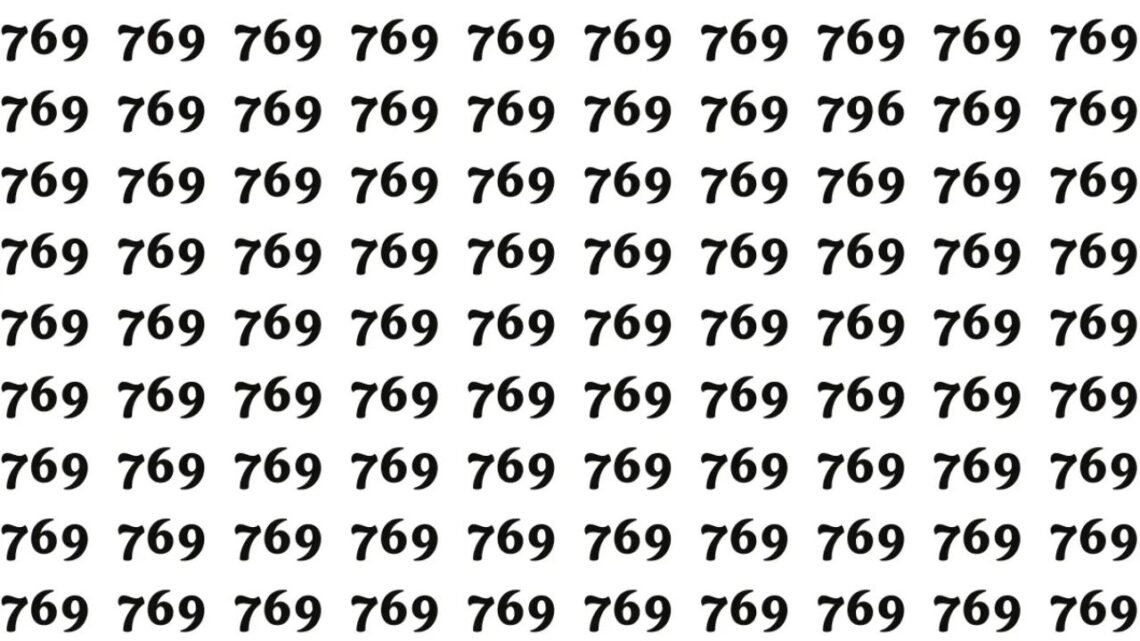Visual brain teasers are viral for a reason — they push our observation and attention to detail to the limit. Today’s challenge: find the number 796 hidden among a sea of 769s.
Sounds deceptively simple, right? But with only 7 seconds on the clock, most eyes will fail to catch the subtle swap. Let’s dive into how this optical illusion works, strategy tips, and why it’s such a compelling test.
The Optical Illusion Challenge: What You’re Up Against
You’re shown a dense grid of numbers — almost all read 769, except one. That one oddball reads 796. The trick? The digits are very similar in shape, so your brain tends to gloss over the change.
- Time limit: 7 seconds
- Common number: 769
- Hidden number: 796
- Key difference: swapping the middle digit (9 ↔ 6)
Here’s a summary:
| Element | Description |
|---|---|
| Total items | Many — grid full of 769s with one 796 |
| Time to find | 7 seconds |
| Core trick | Middle digit is altered — 769 becomes 796 |
| Difficulty level | Very high for casual observers |
| Purpose | Test speed, focus, pattern recognition |
Why It’s So Hard to Spot 796
1. Pattern Uniformity
Your brain loves patterns. When it sees multiple 769s repeating, it starts to treat them as a uniform block. Any deviation suddenly becomes camouflaged in the repetition.
2. Tiny Difference in the Middle Digit
The shift from 769 → 796 is subtle: the “9” in the middle gets replaced by “6”. Our peripheral vision is often not sensitive enough to notice that change instantly.
3. Time Pressure
Seven seconds is barely enough to scan a few rows, let alone examine each number carefully. The time constraint forces you to rely on pattern recognition, which often misses the odd detail.
4. Visual Fatigue
After staring at many similar digits, your eyes tire. The brain begins to “tune out” repetition and misses small shifts.
Step-by-Step Strategy: How to Spot 796 in 7 Seconds
Here’s a methodical plan to improve your odds:
- Don’t read each number fully — instead, isolate the middle digit in each trio.
- Scan row by row or column by column, focusing your vision on the middle digit region.
- Look for breaks in uniformity — any slight shift in the middle digit’s shape is your clue.
- If time permits, zoom in on clustered zones (center, or corners) where designers often hide the anomaly.
Once you internalize that technique, your speed and accuracy will improve with practice.
The Solution Revealed
If you didn’t spot it in time:
- The 796 is hiding among the many 769s.
- The critical difference is the middle digit. In every 769, you see “7–6–9.” In the odd one, it reads “7–9–6.”
- Now that you know where to shift your focus, future puzzles like this become easier to crack.
Why Optical Illusion Puzzles Matter — More Than Just Fun
These challenges aren’t just mindless entertainment. They serve multiple cognitive purposes:
- Sharpen attention to detail — you learn to notice small differences quickly.
- Boost visual processing speed — you force your brain to make faster, more precise judgments.
- Train pattern recognition — by playing with repetition and outliers, you learn to trust subtle cues.
- Stress resilience — doing puzzles under time pressure helps reduce anxiety under real-world fast decisions.
This optical illusion — finding 796 amid 769s in just 7 seconds — is a clever test of raw perceptual power. It tricks casual observers because human vision naturally smooths over repetitive patterns.
But once you understand the trick (focus on the middle digit), your success rate jumps dramatically.
Don’t worry if you missed it on the first try. The beauty of illusions is how they teach you where to look. Practice, challenge friends, and gradually reduce your time — soon spotting such hidden anomalies will feel natural.
Want a series of these puzzles to sharpen your skills further? I’ve got plenty — just say the word!
FAQs
Why exactly 7 seconds?
Seven seconds is short enough to put pressure on you, forcing reliance on instinctual vision over slow, conscious scanning. It’s a sweet spot for difficulty.
Can this illusion be modified (e.g. more numbers or longer time)?
Yes — variations might include more rows/columns, more decoys, or a longer timer (e.g. 9 or 10 seconds) to increase or decrease difficulty.
Does practicing these puzzles actually improve vision or attention?
Yes — repeated practice strengthens your ability to catch small changes, process visual info faster, and maintain focus under pressure.
